TeleVue Distribution ![]() History
History ![]() TeleVue Index
TeleVue Index ![]() News
News ![]() Notes & Interesting Articles
Notes & Interesting Articles ![]() Pricing
Pricing ![]() Products
Products
Accessories ![]() Eyepieces/Oculars
Eyepieces/Oculars
![]() Mounts
Mounts ![]() Starbeam Sight
Starbeam Sight ![]() Telescopes
Telescopes


TELEVUE: A HISTORICAL PERSPECTIVE
The names TeleVue and Al Nagler are synonymous among the international astronomy community (and increasingly with the birding community) with revolutionary telescope and eyepiece designs in production since 1977, and with the introduction of the first truly "fast" production Aplanat and Apochromat 70mm to 140mm aperture refracting telescopes for photo visual applications in birding, panoramic observing, and astronomy.
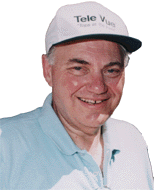 Albert Nagler (b. 1935) was born in and grew up in the Bronx, New York. As a youngster his interest in astronomy was inspired by a visit in 1948 with his father to the Hayden Planetarium where the renowned Carl Zeiss Jena Planetarium projector demonstrated the changing night sky. His interest grew and soon led to the acquisition of his first telescope, a 3-1/2 inch aperture "Skyscope" Newtonian reflector telescope. This $30 instrument housed the mirror optics in a cardboard tube and included pipe fitting legs. When in his early teens (around 1949-50) Mr. Nagler joined the "Junior Astronomy Club" at the Hayden Planetarium. Participation in an astronomy club is a course that to this day is suggested by Company Seven for those who wish to explore or advance their interest in astronomy. In these days before space flight where much was still left to the imagination a bright youngster could go far...and so he would!
Albert Nagler (b. 1935) was born in and grew up in the Bronx, New York. As a youngster his interest in astronomy was inspired by a visit in 1948 with his father to the Hayden Planetarium where the renowned Carl Zeiss Jena Planetarium projector demonstrated the changing night sky. His interest grew and soon led to the acquisition of his first telescope, a 3-1/2 inch aperture "Skyscope" Newtonian reflector telescope. This $30 instrument housed the mirror optics in a cardboard tube and included pipe fitting legs. When in his early teens (around 1949-50) Mr. Nagler joined the "Junior Astronomy Club" at the Hayden Planetarium. Participation in an astronomy club is a course that to this day is suggested by Company Seven for those who wish to explore or advance their interest in astronomy. In these days before space flight where much was still left to the imagination a bright youngster could go far...and so he would!
Mr. Nagler attended the Bronx High School of Science, where in the "Scientific Techniques Laboratory" with the guidance and assistance of Mr. Charles Cafarella, and with diagrams and articles in amateur telescope making magazines and books Al built a 350-pound, 8 inch aperture (diameter) f/6.5 Newtonian telescope with a hexagonal optical tube made of wood, and a mount made from cast iron pipe fittings that would gradually be refined over the course of several years. The mirror optics for the telescope were ground and polished from raw materials furnished in a kit sold by "Precision Optics", a company then located on 163rd Street in the Bronx. The Precision Optics company was actually operated by an optometrist; at that time there were few suppliers of amateur telescope making components, and most of those who could be found were part time or incidental operations. The telescope which Mr. Nagler completed was so well regarded an accomplishment that at his High School graduation in 1952 Mr. Nagler was awarded a one inch "Starrett" precision measuring micrometer as the "Shop Award" prize.
In 1955 Mr. Nagler wrote an article describing the design and construction of his 8 inch telescope for a national magazine "Mechanix Illustrated". Mr. Nagler recalled that the $80 fee he received for authoring that article was the first income he earned related to telescopes and astronomy. The 1955 "Mechanix Illustrated" article he wrote gave Mr. Nagler the confidence to pursue a career in optics which would begin with his employment by the "Farrand Optical Company".
It was in about 1954 or 1955 that Mr. Nagler first attended an annual amateur telescope makers convention and star watch activity that was started by Russell Porter and which is still sponsored by the Springfield Telescope Makers. The event is known as "Stellafane" and is held near Springfield, Vermont. The convention tradition dated back to 1926 although it was not always an annual event. This annual event brings together many people who share the interest in astronomy and the building of telescopes. At the event are lecture series, displays of telescopes and accessories, a swap shop, prizes for accomplishment in areas of telescope making are awarded. Before World War II Mr. Porter moved to California to work on the engineering of the now famous Mt. Palomar 200 inch "Hale" telescope. Burton Willard was an amateur telescope maker who recently wrote a biography book about Russell Porter; Willard was at Stellafane in 1958 when Al Nagler won third prize and Burton won first prize for his telescope. Willard as well as Mr. Nagler still continue to visit to this shrine of amateur telescope maker (ATM).
The 8 inch telescope that Mr. Nagler made in High School telescope would eventually evolve into a 350 lb., 12 inch aperture f/5.2 system. In 1972 Al Nagler took the telescope to Stellafane and won first prize in the Newtonian telescopes category for innovation. Among the features of this telescope were the perforating of the secondary mirror resulting in it passing effectively the light of a 5 inch aperture, and 10 inch around it. A negative (or "Barlow") lens was employed behind the secondary mirror in order to project the light further back and out of the side of the optical tube to a guiding port. Nagler could therefore guide through one port and image through the main focuser simultaneously; this with complete freedom of concern from mirror shift or tube flexure. The results were precisely guided astrophotographs. Mr. Nagler retains this telescope, and some of the astronomical images which were 35mm exposures of up to 80 minute long, yielding resolution on a 16" x 20" enlargement of 3 arc. seconds. And all of this was done on the relatively primitive Kodak "Plus Pan" black and white film of the day.
Mr. Earle Brown was Chief Project Engineer at Farrand Optical Company, and he too was an amateur telescope maker. Mr. Brown wrote articles in the original "Amateur Telescope Maker" book and managed the "Gleanings for Amateur Telescope Makers" section of the "Sky and Telescope " magazine (this was well before Arthur Cox). It was from Mr. Brown that Al Nagler would learn of, and then be attracted to work at Farrand in 1957, where he continued through 1973. Mr. Clair Farrand had founded the company that bore his name, the facilities were at the time was located in the Bronx, N.Y. The two building complex consisted of a large garage, and the other was a large industrial building which would later (when the company moved to Westchester County, N.Y.) become a nurses apartment building for a local hospital. Among his credits Mr. Farrand was one of inventors of the cone loudspeaker; his company became involved in optics and manufacture. Farrand Optical Co. also built complicated military bombsights during World War II.
Mr. Nagler recalled "it wasn't until much later that I developed an interest in refractors, conceived originally as test instruments for my eyepieces, and I have an 8-inch aperture scope for my own use. The f/10, 4-element folded design with an 8-foot wooden tube was dubbed the "snake coffin" by my friends. Like all amateurs, I have had my share of unusual situations. Once a policeman considered arresting me for carrying a coffin illegally in a car when I was on the way to meet my observing buddies with my wooden hex tube 8-inch Newtonian in my first car - a used "Checker" cab. Another time, when coming home from observing with my friends, my Checker cab threw a connecting rod on a country road. I went for help, a frozen hulk in my old brown mohair coat, hunching along the side of the road. A police car screamed to a halt and an officer with a flashlight told me how lucky I was since at first glance he was considering shooting a stray bear. Memories like these are treasured additions to the satisfactions that come from amateur astronomy."
Working at the Farrand Co. under the aegis of Martin Shenker, Chief Optical Designer (also a graduate of the Bronx H.S. of Science) exposed Mr. Nagler to people such as Dr. Tronnier. It was Dr. Tronnier who designed the "Super-Farron" f0.87 lens, while previously he had worked for the German "Schneider" company during World War II on the development of the very wide angle (90 degree apparent field of view) oculars employed in many observation binoculars and sights although Al was not aware of this at the time. The knowledge gleaned by such associations, and further work experiences would not be lost on Mr. Al Nagler. Al Nagler would go on to become Senior Optical Designer at Farrand, and he became involved in tasks including the design of the NASA Apollo program astronaut lunar landing visual simulator. This simulator had a 110 degree field of view projected to infinity so that celestial star fields, earth orbit, rendezvous, and lunar touchdown were realistically simulated. Mr. Nagler designed optical probes used in simulators that offered fields of view of up to 140 degrees! These employed optical characteristics that evolved in his mind over some years so that by 1979 the eyepiece that would be known as the "Nagler" had been developed and prototyped. Later, while working as Chief Optical engineer for Keystone Camera, Mr. Nagler determined and set a new course for his career.
THE START OF A NEW VENTURE, AND THE FIRST REVOLUTION

Right: TeleVue's original advertising logo.
Established at Spring Valley, New York in 1977 "TeleVue Optics, Incorporated" was involved with the design and marketing of projection television lenses under TeleVue, and the "Telekit" trademarks; the AstroSystems company since uses that trademark for the line of Dobsonian telescope kits. Some of these projection television lenses sold through Edmund Scientific!
But, TeleVue would make its first mark in astronomy by revolutionizing a here to fore little appreciated aspect of optical system: the ocular (or eyepiece). One should understand that all telescopes work by gathering light and bringing the rays to focus at the "focal plane"; this is the sole image formed by a telescope objective lens (or mirror). An ocular is attached to the telescope focuser and adjusted in or out so that the focal plane of the telescope is positioned at the field stop (focusing plane) within the ocular. The eyepiece will enlarge the image produced by the telescope so it is the ocular which will greatly determine the magnification and actual field of view to be seen by the observer. Over the years as an amateur astronomer, Mr. Nagler had developed a preference for observing the large extended astronomical objects and these included nebulae, star clusters, as well as the relatively small bright objects such as the planets and moon. Unfortunately, there were few telescopes of the day capable of offering both good light gathering and low magnification wide field (or "rich field") views. And ironically, the few available wide angle oculars when used on fast, low magnification telescopes tended to blur with astigmatism towards the periphery of the field of view.
Telescope eyepiece development had essentially been stagnant, with most designs of the day being decades old, mostly predating World War II. The best wide angle eyepiece that was commercially available at this time was a design with a 60 to 65 degree apparent field of view, known as the "Erfle" design (by Heinrich Erfle b. 1884 - d. 1923). This fundamentally dated to 1917 when Erfle, working for the Carl Zeiss Jena works patented a practical design for a wide angle ocular that since 1918 has appeared in many of the better binoculars and telescopes. The Erfle eyepiece had been improved somewhat since 1917 especially for binoculars and military optics. However, the first real innovation in eyepiece design for astronomy in some decades would come with the development and delayed introduction of the "Nagler" design.
To achieve an unprecedented level of correction for astigmatism, and to produce a flat field over a very wide field of view had been incompatible goals in eyepiece design. Mr. Nagler realized that one could produce an ultra wide angle ocular with as much as an 82 degree apparent field that could correct for most aberrations, but it would retain undesired astigmatism. The innovation by Mr. Nagler was to eliminate the residual astigmatism by the employment of a negative lens custom matched to produce the desired performance. This was unprecedented - nobody before had ever attempted to integrate a negative lens and ocular as a matched unit before. In 1979 the Patent was awarded for the TeleVue "Nagler" design.
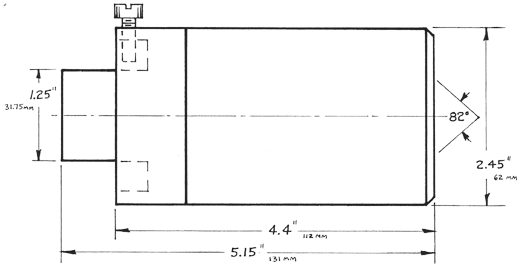
Above: This illustration drawn by Al Nagler appears in the first 13mm Nagler brochure published in 1980.
courtesy of David Nagler
The prototype Nagler eyepiece was manufactured with a focal length of 13.1mm. These prototype 13mm Nagler eyepieces were all made in the United States and air spaced elements were multi layer anti reflection coated. However, Mr. Nagler noting the high cost of production in the U.S. compared to the costs overseas and aware of the ability of Japanese manufacturers to consistently manufacture small lenses to very stringent specifications, decided the future production Nagler models would be made in Japan, and some models would eventually be made in Taiwan.

Right: TeleVue Nagler Type II design cross section drawing (similar to original 7 element Nagler design) scaled to 9mm focal length. Eye lens is at right.
courtesy of Martin Cohen
What has become known as the original Nagler design is a sophisticated seven element lens incorporating high index elements of SF1 and SK16 glass which are set in four groups. Every air spaced element is fully multi-coated to reduce the light loss and possibility of "ghost images" due to internal reflections, and to increase contrast. As with all TeleVue eyepieces, the lens edges and all internal fittings are treated with a non reflective black finish. An interesting observation when studying the design is the fact the the "Field Stop" of these oculars is actually within the barrel assembly, behind the matched doublet negative lens group. This lens was therefore quite expensive to manufacture compared to the other simpler eyepieces of the day.
The prototype 13mm Nagler eyepieces were "convertible" in that the upper body housing the very large five element lens group was removable from the negative lens group so that this upper body could be employed alone as a 30mm ocular albeit lacking the degree of correction that Mr. Nagler preferred to offer with the lens when used complete with its matched negative element.
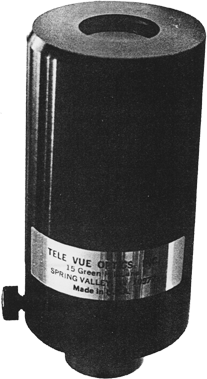
Left: Original TeleVue 13mm Nagler ocular, shown full scale
courtesy of TeleVue
The 13.1mm Nagler provided an unusually long eye relief of 18mm when compared to similar focal length alternatives then available; but keep in mind this is actually about a 30mm focal length upper body. The design provides excellent correction for use with telescope systems as fast as f4. The 82 degree apparent field of view was marketed as "almost double the area of a 60 degree field, and more than three times that of 45 degree orthoscopic eyepieces", with "zonal area of exceptional image quality probably at least 5 times that of any other commercially available astronomical eyepiece".
Mr. Nagler reconsidered placing such a revolutionary but costly product on the market. While the Nagler was actually his first commercial eyepiece design, he justly questioned from a buyers perspective who would pay $250 for an eyepiece from an unknown company, one that was making incredible (but proven) claims like "10 times sharper, 3 times the field, 4 times the eye relief..." So, Mr. Nagler decided to hold off production of the Nagler design until the credibility of his new company would be firmly established within the community.
TO ESTABLISH CREDIBILITY IN THE MARKETPLACE
Over the years Mr. Nagler had developed a collection of favorite production eyepieces for use with his own telescopes; some of these were a four element "Plossl" design. He used this Plossl set as the reference standard that he would meet or beat when he set out to develop a premium quality American product.
The first advertised production TeleVue eyepieces were a symmetrical, scaled "Plossl" (four element) series of 1.25" diameter barrel introduced in 1979. The advertising highlighted parfocal mechanical design (so that one could change from one eyepiece to the other with little if any focus adjustment at the telescope), multi coatings to improve apparent brightness and contrast, superior construction materials and techniques including darkening all mechanical interior fittings and lens edges, and a fifty degree apparent field of view. The barrels are threaded to accept common 1.25 inch diameter filters; such accessories as color or neutral density filters are used to help make viewing the moon a more comfortable experience, or to bring out subtle features on the planets.
By the Fall of 1980 the advertisements by TeleVue (then selling direct) offered 7.4mm, 10.5mm, 17mm, and 26mm focal lengths. Each sold for $45, although one ad in October 1980 notes that if one ordered the entire set of four Plossl then a free blue plastic carrying case would be included. The 26mm Plossl with its fine balance of eye relief, field of view and reasonable magnification with most telescopes would become so popular that it (and other 26mm Plossls) was to become included as a standard eyepiece furnished with many telescopes to be marketed since the 1980's continuing to today.
A price increase to $55 each may have been purely coincidental with the favorable review in "Astronomy" magazine of August 1981 where the reviewer noted "Sharpest I ever used"; this would be among those quotes appearing in future TeleVue marketing literature.
THE "MIND BLOWER"
With the initial success of his Plossl series, Mr. Nagler felt confident so that in 1980 TeleVue formally announced the "mind blower" 13mm Nagler eyepiece. The first 13mm Nagler brochure of 1980 lists a cost of $250.00 plus shipping. A hand drawn performance comparison of spot sizes across the field drawn by Mr. Nagler comparing the then popular Erfle wide angle eyepiece design against the Nagler design was included. The barrel design allows the 13mm to be used on either a 2" or 1.25" diameter focuser. The production eyepieces would not be designed as "convertibles" in order to maintain the level of perfection he preferred to offer.
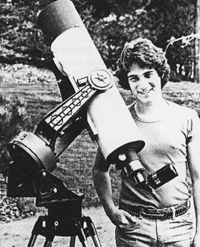
Right: David Nagler, Al Naglers son with a 6"f5 refractor telescope with an original TeleVue 13mm Nagler ocular. This photograph appears in the first brochure of the 13 Nagler published in 1980. Note the Celestron 8 fork mount.
(photo courtesy of David Nagler)
Up to 1980 the retail sales of TeleVue products were made only direct from TeleVue in New York by mail order. Soon afterwards, a few specialty telescope dealers including Leo Henzel (first dealer to advertise it), and Ed Hirsch were offering the TeleVue product line. Company Seven Astro-Optics Division would join in 1984 as a full line stocking retailer after the staff and their friends were awe inspired after evaluating TeleVue oculars in the field.
In 1982 the TeleVue 32mm Plossl came out although the original TeleVue Plossl design was done in 1979. The 32mm would provide a good balance of correction, sharpness and clarity. With its 50 degree apparent field of view it would show as much area of sky as could be seen by any 1.25 inch diameter barreled eyepiece. The 2 inch diameter 55mm Plossl, and the 1.25 inch 40mm and 32mm Plossl eyepieces were designed about 1 year apart. The large 55mm Plossl was the first conventional production 2" diameter TeleVue ocular. The 55mm Plossl with its 50 degree apparent field of view was announced with the 1.25 inch diameter 40mm (with 43 degree apparent field of view and very long eye relief for spectacle wearers) and their first 1.25 inch diameter Barlow lens (of 2.5X) by January of 1982. By then the 55mm cost $150, the 40mm $70, the 7.4 through 26mm Plossl models being $55, and the 2.5X Barlow $55.
The 13mm and 21mm Plossl were designed as "fill ins" to the line. Their prototypes were first shown at a small astronomy day show at Kutztown, Pennsylvania in 1981. Mr. Nagler continues to demonstrate prototypes of new products at such activities as TeleVue draws much feedback, loyalty and support from the amateur observer.
The signs of success were becoming evident and in 1982 TeleVue moved into a facility in Pearl River, New York. And now with credibility established, TeleVue began to advertise the 13mm Nagler with two other Nagler models in 9mm and 4.8mm. Boasting "U.S. Patent #4,286,844 "Ultrawide Angle Flat Field Eyepiece", the 13mm and 9mm Nagler had been refined with a unique mechanical barrel design that allowed them to be used on either a 2" or 1.25" diameter focuser. The cost of these made in Japan to TeleVue specifications was now $200 for the 13mm, $175 for the 9mm, and $150 for the 4.8mm.
1982 saw the introduction of the TeleVue 90 degree angled 2 inch mirror diagonal. This diagonal permits an observer to employ a wide selection of 2 inch or 1.25 inch diameter oculars; and not only did it open up a world of wide sky viewing to many but it also replaced many inferior diagonals commonly furnished by manufacturers with their telescopes thereby providing clearer views. Incorporating a precision ground, highly polished flat mirror diagonal (now quoted as 1/10th wave) coated with enhanced aluminum reflective coating. The male 2 inch barrel is threaded to accept 48mm photo and visual filters. The interior is fully anti reflection coated and baffled.
Note: the view when using a telescope with any 90 degree prism or mirror will appear to be right side up, and is reversed left to right. This is not usually a problem for astronomy or nature observing because the image quality provided by the high quality mirror and 2 inch diameter panoramic oculars is exceptional. And so while we do offer optional 45 degree inclined image erecting prisms, these prisms can only accommodate 1.25" oculars. Furthermore, the erecting prisms will not provide image quality to equal that of a mirror diagonal, this is particularly perceptible at higher magnifications. For low to medium magnification applications where one needs correct images (such as to read numbers, etc.) then the erecting prism should be suitable.

Left: Trademarked TeleVue logo used since July 1982.
(photo courtesy of Martin Cohen)
In July 1982 TeleVue ran their first full page advertisement in "Sky & Telescope" magazine. This ad now showed a logo which has been trade marked and remains in use in either black against white background or vice versa. Featured in the ad were the TeleVue Plossls in focal lengths of 7.4, 10.4, 13, 17, 21, 26, 40, and 55mm (the 55 having been designed in September 1979). Also shown were 13, 9, and 4.8mm Nagler, the 2" mirror diagonal, 2.5x Barlow, and the 5" f4 MPT Multi-Purpose Telescope.
By 1982 the design was finalized for a new six element eyepiece design providing a 65 degree apparent field of view, to be marketed as the "Wide Field" series these were introduced in about 1983, and Patented in 1985. Initially offered in the 19mm, and 24mm focal lengths with 1.25 inch barrels, and 2 inch diameter 32mm and 40mm focal lengths, the Wide Field design appealed to observers due to their improvement of correction over more traditional wide angle designs of the day. The 40mm Wide Field was about the most massive eyepiece available to the amateur and it provided a breathtaking view that in area approached the TeleVue 55mm Plossl by showing 90 percent (by diameter) of the 55mm Plossl field of view at a higher magnification. One early accolade for the 40mm was that Michael Rudenko discovered Comet Levy-Rudenko using his 40mm Wide Field (while the David Levy chose the 13mm Nagler for critical studies of the comet he co-discovered). In 1984 TeleVue added a 15mm Wide Field eyepiece, this was followed soon after with the introduction of the 7mm and 11 mm Nagler oculars.
THE "PERFECT" TELESCOPE...
In 1982 the first telescope offered by TeleVue was introduced to the public, the "MPT Multi-Purpose-Telescope". This instrument is a 5 inch aperture f4 refractor with a 509mm effective focal length. The MPT telescope was designed for use not only in conventional applications, but also for the quality control testing of new TeleVue eyepieces. The first MPT instrument made remains in service at TeleVue testing at f4, and then with the iris diaphragm set at f20 for inspecting eyepieces for cleanliness.
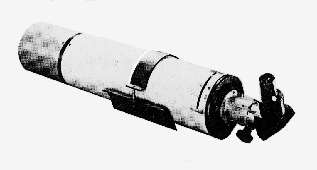
Right: TeleVue 5 inch f4 MPT. Note iris diaphragm near rear of optical tube
(photo courtesy of TeleVue)
Al Naglers patented "MPT" is a four element design based on the "Petzval" concept. Several TeleVue telescopes (including the 101 and the 140mm telescopes) derive from the MPT. A two element air spaced achromatic objective lens at the front of the telescope passes the light to a doublet lens positioned at the rear and before the focuser of the telescope; this doublet lens group functions to 1) reduce the effective focal length, and 2) reduce or eliminate curvature of field. The "MPT" included a 2 inch focuser, 2 inch mirror diagonal with reducer of 2 to 1.25 inch, with 20X and 70X TeleVue Plossl eyepieces, a tripod adapter, and carrying case. The telescope weighed 12 lbs. and was only 33 inches long. The obvious appeal of such an instrument was not lost on several lucky buyers; the 5 inch f4 MPT sold by July 1982 for about $1,975 at a time when there were very few large refractors of less than f11 to f15 available on the market.
By 1983 Al Nagler had redefined his vision of what a perfect telescope might be for many observers. Compared to the other popular telescope designs, the refracting telescopes offer the most natural, high contrast, three dimensional views of the brighter objects; they certainly have been the choice of professional visual astronomers. Telescopes such as TeleVue MPT proved the concept of using a refractor for deep sky observing and more so for imaging; by the time one could build a large enough mirror telescope to show what a comparable refractor could show, the field of view through the mirror systems would be relatively narrow.
However, most refracting telescopes up to this time were relatively high magnification instruments affording relatively narrow actual fields of view. Recent optics innovations had resulted in relatively fast f9 or so telescopes, compared to the previous common f12 to f15 ratio Achromat, this afforded wider fields of view better suited to deep sky observing. The TeleVue MPT had been a good test bed for Al Naglers vision of just how practical and versatile an f5 refractor could be. However, the market place had yet to be convinced and the MPT 5 inch telescope was too costly to gain the prerequisite market share. So Mr. Nagler went back to work on an alternative.
BEAUTIFUL PERFORMANCE
Coincident with the coming visit of "Comet Halley" TeleVue announced a contest to determine a name for a new telescope that would combine 20th century optics with 19th century appearance in brass, thus was born the beautiful 4 inch aperture f5.5 "Renaissance" telescope in 1984. A telescope just at home in a living room as in a personal observatory, the Renaissance was (and remains with its improved successors) unique in that available production brass telescopes are typically mediocre small aperture achromatic telescopes with narrow fields of view and little versatility. While the Renaissance is a large aperture telescope with a very wide range of magnification/fields of view, and the ability to accept film or video cameras to perform imaging. The Renaissance has the capacity to show panoramic views as wide as 5 degrees at 10Xand magnifcations of up to 286X to clearly reveal major features of the planets and identify a number of deep sky wonders. The 12 lb. telescope (with 2 inch diagonal, or 10 lb. 12 oz. for the tube alone) in its furnished carrying case was compact enough so that it could be carried onto most major commercial aircraft, with one exception being the L-1011 where the overhead compartments were unusually small. By November 1984 our selling price for the telescope with its 2 inch diagonal, 26mm Plossl, in a fitted hard shell carrying case was $895.00!

Above: TeleVue "Renaissance" 550mm f5.5 Aplanat telescope U.S. Patent #4400065; 1. air spaced doublet objective, 2. mounting collar,
3. rear cemented doublet lens, 4. 2" focuser, 5. 2" mirror diagonal, 6. 2" to 1.25" reducer, 7. eyepiece (26mm Plossl)
(courtesy of Martin Cohen)
The production models manufactured in 1984 and in 1985 bore a small plaque noting the Comet Halley event. It was a "Renaissance" (Serial No. 1019) that was evaluated in the March 1985 issue of "Modern Photography" magazine that earned "excellent" ratings on resolution tests, and "High" ratings for contrast with praise that included "with image quality beyond ordinary camera lenes". To our surprise, in 1986 "Audubon" magazine rated it as the top refracting telescope in a comparative survey of birding telescopes (the "Questar Field Model" a compact Maksutov-Cassegrain telescope was rated top choice over all); but we found it hard to believe that too many birders would haul such a telescope very far.
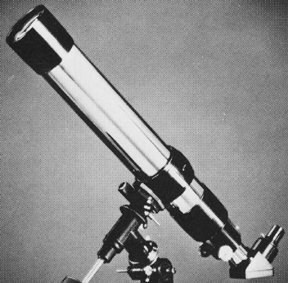
Above: TeleVue "Renaissance" 550mm f5.5 telescope on optional equatorial mount
(photo courtesy of TeleVue)
TeleVue introduced a lightweight wood tripod with a camera tripod head, marketed as the "Pan Head Mount" this mount was ill suited for use in astronomy. Soon afterwards TeleVue introduced a new mount that would remain in production to this date with few adaptations: the "Panoramic" mount. An incredibly simple to use mount that cradles a telescope at its center of gravity for ideal balance at any viewing position. The mount head is made of fully machined of aluminum with brass elevation bearings and azimuth nylon bearing providing smooth vertical travel from below the horizon up to 85 degrees overhead, and full 360 degree rotation. Clutches on the elevation axis permits the operate to compensate for changing accessory loads, or with the Azimuth control to lock the telescope in place. The working range put the telescope at between three to five feet high. The "Panoramic" mount solved a problem of portability and ease of use for those who are frustrated by the weight and relative complexity of equatorial mounts, and it provides a mount far better suited to terrestrial applications than an equatorial mount or common camera tripod would be.
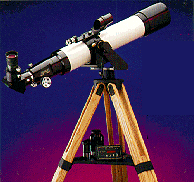
Right: Modern TeleVue Ash Gibraltar Mount with optional 101 telescope, Starbeam sight, oculars and SkyTour CPU on accessory tray
(photo courtesy of TeleVue)
TeleVue followed the original Pan Head Mount with a much more rigid design which is better suited to support the 4 inch telescopes particularly when operating them at higher magnifications: the "Gibraltar" mount. Both of these mounts remain in production with either a beautiful ash tripod in natural finish with black trim, or a walnut finish with solid brass journal and plated brass trim. (Yes, ash is the hard wood used to make baseball bats) Since its introduction the "Gibraltar" head has been engineered to accept optional encoders to feed a "Digital Setting Circle" CPU such as that offered by TeleVue and third party units; this helps one to navigate the sky and find objects that might be hard to find particularly from suburban settings.
The "Renaissance" telescope was originally pictured on an unsuitable economical German mount. However, to properly match the telescope to a suitable mount was not a simple task; customers who wanted an equatorial mount were initially left to their own devices. In January 1985 TeleVue introduced an adapter plate to allow owners to mount the "Renaissance" onto the Vixen "Super Polaris" mount; this popular German equatorial mount was distributed by Celestron Int'l. After some research TeleVue took on the distribution of the Japanese made (by "Carton") RSM-2000 "Systems Mount" German equatorial mount. TeleVue offered a modular approach with options including an American made ash wood tripod (as that sold with the "Gibraltar" mount) or aluminum extendable tripod legs, internally fitted Pole Finder telescope with reticle illuminator, and battery powered clock drive. The mount featured clutches on both axes with manual slow motion controls.
A CHALLENGE MET...IN SPADES
By 1985 TeleVue sales of eyepieces among the serious astronomical community continued to grow in no small part due to word of mouth, while other telescope distributors continued to offer traditional comparatively simpler designs. One of the first prominently ugly episodes in the business side of amateur astronomy happened when Meade Instruments (a large telescope manufacturer and distributor) took the TeleVue concepts and designs which were available at the U.S. Patent office and they arranged to have the entire TeleVue eyepiece product line essentially mimicked one for one at a factory in Japan. The external similarities of what would be marketed as the Meade "Series 4000" were obvious:
for TeleVue Nagler: 4.8mm, 7mm, 9mm, 11mm, 13mm Nagler
Meade introduced: 4.7mm, 6.7mm, 8.8mm and 14mm "Ultra Wide" (which ironically is the title of the Nagler Patent)
Similar duplication of the other TeleVue oculars by design concept, and focal length were done from the 7.4mm Plossl up to the 55mm Plossl (where Meade claimed a 56mm), and the TeleVue "Wide Field" series. And for every proven performance specification published by TeleVue, the many pages of Meade product advertisements claimed an improvement.
Regardless of Meade marketing efforts, the experience at Company Seven was that given the choice, the amateur astronomy community generally preferred TeleVue; to some degree this was a loyal response to Al Nagler who is perceived as the true innovator and a fellow observer. This was repeatedly borne out at the major national astronomical conventions where TeleVue eyepieces retained the largest representation. Indeed testimonials such as "Use the best; TeleVue. After all, the eyepiece is half your telescope" by Dr. Jack Marling, President of Lumicon (a reseller of Meade and TeleVue products). Roland Christen, an accomplished lens maker would select TeleVue as his personal eyepieces, and select TeleVue as the line to suggest and resell with his own "Astro-Physics" telescopes. Martin Cohen, Director of Company Seven would carry much of the TeleVue line in his eyepiece case (and incredibly enough a couple of the older discontinued Meade "Research Grade" series of Orthoscopic and Wide Angle/Erfle models!).
About the time of their introduction, at one Company Seven sponsored public observing activity the regional sales representative for Meade brought the new oculars to compare against those of TeleVue in a "blind" test. The tests were done with a Celestron C-11 at f10 and at f7, a Meade 8 inch f6 Newtonian, and a Meade 4 inch f10 achromatic refracting telescope. He advised Martin Cohen that the Sales Manager at Meade had assured him that with deep price discounting, and pages of colorful ads "the river would run red with TeleVue". During the course of several comparative viewing tests the Meade representative did acknowledge that the TeleVue oculars generally afforded a superior view under critical scrutiny, although there were few exceptions such as with the 14 Ultra Wide Angle, and the Meade oculars were still quite good.
"BECAUSE YOU ASKED FOR IT"
TeleVue was well aware of the challenge and Mr. Nagler replied with more innovative and superior designs.
Al Nagler considered making Naglers of longer focal lengths than the 13mm. He realized that simply scaling up the 13mm Nagler to longer focal lengths produced problems of performance, size, weight, and cost. To go further he had to develop the eight element Nagler Type 2 design. The Type 2 eyepieces are scaled to provide an eye relief similar to about that of the 9mm Nagler. This reduced the weight and size of the eyepieces to something that could be managed by most telescope two inch focusers. This scaling also reduced the cost compared to what it would have otherwise been.
On 18 October of 1986 at Company Sevens Laurel, Maryland showroom Mr. Nagler demonstrated the new evolution of the original Nagler design: this would be the gargantuan 20mm "Nagler Type 2". The demonstration caused much excitement, and when it became available even with a record a list price of $425.00 the incomparable 20 Nagler immediately became the "must have" and even today in 1998 its closest rival is a TeleVue 22mm "Panoptic" ocular. In January 1987 the Nagler 2 design would be made available in 12mm ($315), 16mm ($360), and 20mm focal lengths.
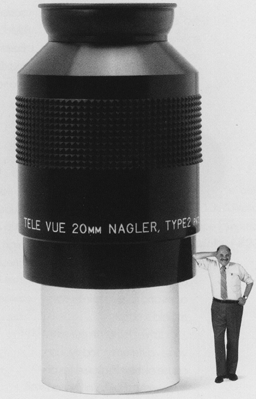
Left: TeleVue 20mm Nagler illustration from the original advertisement.
(courtesy of Martin Cohen)
The very clever photograph that accompanied the first advertisement introducing the awesome TeleVue 20mm Nagler Type II to the astronomical community. The advertisement appeared with the caption along side "shown actual size" and so at Company Seven we placed a copy of this ad on the wall to show people just how short Al Nagler really is!
The 20mm Nagler II was the only one in the series that could only be accommodated in a 2 inch focuser; it is a unique eyepiece providing the highest practical magnification for such a wide field of view - hence the advertising phrase "because you asked for it".
By 1986 Al and Judi Nagler's son David Nagler was working at TeleVue part time, and then in 1988 he would become Operations Manager.
LIKE A TELESCOPE...ONLY SMALLER
In the Fall of 1986 TeleVue announced a new telescope the 76mm (3 inch) "Oracle" a 560mm f7.4 Apochromatic refractor telescope, the prototype being shown at Company Seven on 18 October 1986. The 6 lb. telescope was furnished with a carrying case, thread on metal lens shade (later models would feature a captive retractable shade), the TeleVue 2 inch diagonal, and a TeleVue 26mm Plossl ocular. The "Oracle" was offered with an aluminum optical tube painted in an ivory color. While the 2 inch diagonal body, focuser, front cell and thread on lens shade were painted in an almost flat black paint, and the focuser drawtube was chrome. When deliveries began in March of 1987 the Oracle sold at Company Seven for $835 and set a new standard of versatile excellence for very compact refracting telescopes.
Prior to the "Oracle" there had been some short focal ratio refracting telescopes on the market, but most were very cheaply made, and none rivaled the Oracle for clarity particularly when operating at the high magnifications necessary to study the planets. This telescope featured a multi coated triplet apochromatic lens, and that was unusual in itself as few companies would go to the expense and difficulty of making a triplet lens for so relatively small a telescope. With TeleVue's 2 inch focuser this provided the light gathering capacity coupled with extraordinary wide field of view ability (showing up to 4.9 degrees!) to reveal the entire "Messier Catalog" of deep sky wonders or be employed for panoramic viewing of a seashore or countryside. The "Oracle" also provides the high power clarity to see changing features on the planets, and still it was carry on luggage portable! This telescope became a choice for beginning astronomers, and a good compact second telescope for those who owned instruments which were too inconvenient to set up routinely. The "Oracle" would also introduce the TeleVue name to the birding community. However, the difficulties of consistently producing high performance triplet apos, and rising costs resulted in the discontinuation of the "Oracle" in 1990.
For 1988 TeleVue would follow up the original "Renaissance" telescope with the "Genesis" telescope. Appearing to be similar in the arrangement of the optics, the Genesis featured improved color correction over its predecessor due in part to the incorporation of a calcium fluorite element in the field flattener positive lens components at the rear of the telescope tube assembly. This also permitted the telescope's effective focal length to reach about 500mm at f5, while retaining a flat field. To shed some weight (at 10 bs. it is 2 lbs. less than the Renaissance) and cost, the "Genesis" was offered in an aluminum tube painted in an ivory color. The 2 inch diagonal body, focuser, front cell and thread on lens shade were painted in an almost flat black paint, and the focuser drawtube was chrome.
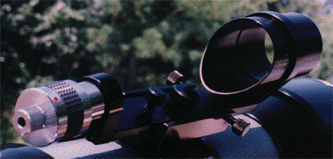
Left: TeleVue Starbeam Sight viewed from the right rear; note chromed illuminator.
A development descending from "Heads Up Display" projects is the unique TeleVue "Starbeam" compact sight. "Although the 9X, 5.5 degree true field capability allows Genesis to operate as its own finder, I thought it would be nice to have a simple finder to point the telescope. The finder had to be elegant in form, function and operation and not have to be removed when storing the telescope. A unit-powerfinder serves these goals best. Choosing an "inverse-Herschelian" design for projecting a small "red star" seemed appropriate. With a 39mm "exit pupil" and unlimited eye-relief, I believe we met our goals. The proof? My wife now actually enjoys finding objects with it!" - AI Nagler. The sight is installed on a simple, easy to adjust bracket so that the sight may be aligned to the telescope. This is a unit power device with an illuminator that projects an adjustable brightness, 10 arc minute diameter red dot onto a precisely made meniscus mirror lens, acting like an inverse Herschelian telescope. This red dot appears to be in the night sky wherever the scope is pointed. The window's 39mm clear aperture and 6 arc minute accuracy make star hopping easy. The illuminator furnished has adjustable in brightness and holds a common button type battery so it requires no external power. TeleVue's Starbeam is "the only red dot pointer worth owning" according to Bruce Wrinkle, Senior Technician at Company Seven.
Al Nagler worked to further improve the relatively medium to low magnification "wide angle" eyepiece designs. As telescope technology had improved and in particular faster refractors were now coming out, the curvature of field resulting from such short focal lengths caused most low magnification wide angle oculars to show images that might be sharp and clear at the center of the field of view, while the image quality gradually deteriorates to a blur at the edges of the field of view. The "Nagler" and "Nagler Type II" oculars are very well corrected for use with such systems however it is not practical to develop the Nagler to greater than the 20mm focal length. By 1991 Al Nagler had developed the solution, and in the January 1992 there appeared TeleVue advertisements proclaiming the new "Panoptic" wide angle oculars to be "sharp as a tack". The new series of oculars were of 35mm focal length in a two inch barrel, and a 22mm with the 1.25/2 inch arrangement (as several Naglers are). Later a 27mm of two inch barrel design, and 15mm of 1.25 inch would be added to the line. And finally, a 19mm Panoptic was developed as an ideal match for the TeleVue "Binovue"ębinocular viewing accessory. With a 68 degree apparent field of view, and with six elements (including four lanthanum crown elements) fully multi coated these set an absolutely unrivaled standard of excellence in their respective class for sharpness, clarity, and brilliance. They are tack sharp to the edge of field even on the most demanding fast telescopes.
TeleVue was by now well regarded as an innovator for its eyepieces, telescopes, but it also set for itself a very high standard of professionalism in its advertising with beautifully illustrated copy done in house. By 1992 the need for a larger facility was again obvious and TeleVue moved its facilities to Suffern, New York.
In 1991 TeleVue introduced another new telescope; this would be a 70mm f6.8 refractor with a 2 inch focuser, unique in its extreme portability: the "Pronto" ED doublet multi-purpose telescope. With deliveries starting by March 1993, TeleVue introduced the 70mm "Pronto" ED doublet refractor telescope stating "since the telescope is the heart of any observing system, I felt the multi-purpose concept of our Genesis telescope would fit beautifully into a smaller instrument. Pronto is a fully-featured, American made telescope for naturalists, beginners and those advanced amateurs looking for the finest quality traveling companion" - Al Nagler.
The first advertisements for the telescope showed that with the lens shade retracted and with a 2 inch diagonal attached it fit nicely across the cover of a popular astronomy sky atlas. Another ad showed the "Pronto" resting across someone's flexed arm just between the wrist and elbow; in a parody of that ad Martin Cohen had an made image of himself with a Astro-Physics 206mm (8.14") f8 apochromat telescope resting along his arm - his arm having been lengthened by a computer graphics house to about 65 inches!
With the first deliveries of the "Pronto" in November 1992 TeleVue set out to regain a place in the market left vacant since the discontinuation of the "Oracle" telescopes. This new telescope would rely on a smaller objective, in an air spaced doublet configuration that would be easier to produce consistently well than the "Oracle" was. By employing "ED" glass, the color correction could be made acceptable and with a 2 inch focuser the telescope is capable of revealing immense areas of sky, or a panorama of the county or sea shore. The "Pronto" remains available with a choice of a TeleVue 2 inch mirror, or 1.25 inch 90 degree diagonal, or a 1.25" image erecting 45 degree inclined prism.
Well, it is certain that Al Nagler hit the mark as the telescope began to gather a number of favorable reviews and fan letters. We expected beginners to buy it, but were indeed surprised at the number of experienced observers who buy this as a second telescope for its portability, and versatility; their uses include: telescope, ultra telephoto lens, guide scope, finder, etc.
 In 1993 TeleVue introduced their fourth-generation 4 inch refractor, an improved version of the conventional "Genesis" and "Renaissance" brass and achromatic telescope optical design, these were distinguished by the suffix "SDF", and would be in production through 1997. The most obvious improvement over the prior series was the color correction of the SDF, that was accomplished by a change of the type of glass employed in the air-spaced front doublet lens to an SD (anomalous) dispersion fluorocrown element. While the rear doublet element continued with the fluorite doublet field flattener. This resulted in a true apochromatic level of color-correction, a first for the TeleVue larger refractors.
In 1993 TeleVue introduced their fourth-generation 4 inch refractor, an improved version of the conventional "Genesis" and "Renaissance" brass and achromatic telescope optical design, these were distinguished by the suffix "SDF", and would be in production through 1997. The most obvious improvement over the prior series was the color correction of the SDF, that was accomplished by a change of the type of glass employed in the air-spaced front doublet lens to an SD (anomalous) dispersion fluorocrown element. While the rear doublet element continued with the fluorite doublet field flattener. This resulted in a true apochromatic level of color-correction, a first for the TeleVue larger refractors.
Right: TeleVue Renaissance SDF telescope, still featuring a lustrous solid brass construction, shown with matching Gibraltar tripod mount for a striking appearance!
The SDF are so well corrected that images are breathtaking across a broad range of magnifications. The effective focal length of the SDF is 540mm at f5.4, an increase of 40mm over the older design. It is operable from low powers, down to 9x, with wide fields of view up to a 4.5 degrees field of view, up to magnifications needed to observe one moon eclipse another transiting in front of Jupiter - throughout these ranges with stunning clarity.
TeleVue continued to internally baffled the main optical tube walls with an uncommonly simple but effective technique. The lenses continued to feature optical multilayer coating process of the air-spaced lenses, as on all the TeleVue eyepieces. So that light reflecting from the surfaces or between lenses is prevented thus eliminating ghost images or flare, improving color rendition, and achieving a dramatic increase in contrast.
Another change for both SDF telescopes was the change from a thread-on separate lens shade/dew cap to a captive retractable arrangement. This reduced chances of the lens shade being lost, and made it possible to extend or retract it to any desired length. Another side benefit, one that Company Seven would exploit, was that this arrangement allowed us to thread on filter(s) or other devices such as a costly Hydrogen-Alpha filter component, directly onto the front cell of these telescopes. In some applications with our device attached, we could still extend the telescope lens shade for function, or simply to aid in protecting the device attached to the front cell.
By this time the TeleVue telescope machined aluminum fittings (front and rear cells, focuser, mounting collar, dew shield) were anodized black. The SDF remains a lightweight, rugged portable telescope, well-suited to traveling in the same provided lightweight hard shell carrying case.
TeleVue's premium 4 inch telescopes would evolve yet again in 1998 with introduction of the TeleVue "101" series Apo telescopes. These incorporate one of the best SD objective optics in the world - remaining the worlds fastest, flat field apochromatic 4 inch telescope of the day - and with the "Renaissance 101" remaining the most beautiful.
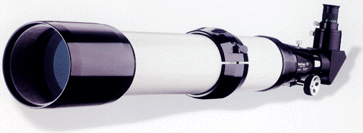
Left: TeleVue 101mm telescope with lens shade retracted, with furnished 2 inch Diagonal and 20mm Plossl eyepiece.
In December of 1994 TeleVue introduced the "Ranger" telescope in an attempt to lure those seeking a less expensive or even more compact alternative to the "Pronto". This model features the same 70mm objective employed by its cousin, with a simpler 1.25" focuser. The focuser is not of the rack and pinion design, and is more resistant to abuse. The lens shade, and carrying bag would be optional. A brass version is also made available.
While the "Pronto" and "Ranger" were highly successful for birding, and accepted by the astronomy community as a whole Company Seven believed that a need was not being met for a telescope of improved performance for astronomy. The Pronto has the field of view and versatility for many uses however, its design and aperture limit it to about 150X and so we judged this to be just below the threshold necessary to routinely obtain views of the planets changing features. Martin Cohen, and others regularly asked Al Nagler (and Roland Christen of Astro-Physics) to develop the idea of an about 80mm f7 well corrected apochromatic telescope, with a 2 inch focuser and degree of correction that would result in performance suitable for observing the "Messier Catalog" and the planets while retaining good portability. Al Nagler listened, and in February 1998 he responded by introducing the TeleVue 85 f7 multi-purpose telescope.
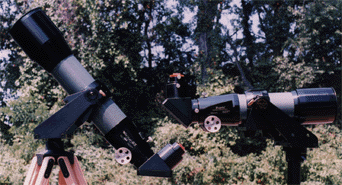
Left: TeleVue 85mm telescope with optional Panoramic Mount, and smaller 70mm Pronto with optional Telepod Mount.
The objective lens of the 85 is an SD air spaced doublet design. The positive element is of a fluorocrown special dispersion glass. This design allows very good color correction about similar to that of the 76mm Oracle design. The 85 objective's four air to glass surfaces have multi layer anti reflection coatings that provide light transmission greater than 94% in the visual wavelengths. So the system has about 135 times the light gathering power of the unaided human eye. The lens is so well figured that it is capable of operating at 200X or more cleanly with optional lenses; this reaches that threshold necessary to routinely obtain meaningful views of the planets. The 85 has extraordinary wide field of view ability (up to 4.6 degrees at 11X) to reveal the entire "Messier Catalog" of deep sky wonders, or for panoramic viewing of a seashore or countryside. Packaged in a fitted carrying case, this telescope with a suitable mount is acceptable as "carry on luggage"; no larger aperture refracting telescope made in 1998 can do this.
In 1995 Mr. Nagler shared with me, and also Robert Reeves of "Amateur Astronomy Magazine" some of his thoughts: "one of the things that always excited me about astronomy is bringing it to the public, and especially to children. I also love the experience and camaraderie of attending star parties. In addition to local and the major national star parties, I have attended two star parties in Australia and one in Japan. Through these, I have come to correspond with amateurs from all over the world. These people, as well as new product developments, make amateur astronomy a continual adventure.
"I'm constantly surprised and awed by the fabulous views friends show me at star parties. Indeed, I have had a number of "goose-bump" astronomical experiences. One was getting out of the car at Ayers Rock in Australia during a trip to see Halley's Comet in 1986. I looked up and saw, for the first time, a totally new and different astronomical universe. The Milky Way was so brilliant it was beyond my imagination. Another "goose bumper" was at the Texas Star Party where I got my first glimpse of Omega Centauri through an 18-inch telescope using my 13 mm eyepiece. Yet another was once finding a comet next to M-1. I was awfully excited to say the least until I checked "Sky and Telescope" and noticed the recommendation to see a comet one degree away from M-1 on that very night.
"I am pushing 60 now, and still love telescopes as both hobby and business. I have worked on eyepieces, telescopes and viewing devices with two major goals: to make astronomy as easy and versatile as possible to encourage, rather than discourage, newcomers, and secondly, to provide a visual experience as close to a "space walk" as possible by obtaining the widest, sharpest, highest contrast views. I am deeply gratified that my work has enhanced the pleasure and growth of the hobby. I think amateur astronomy is the best hobby in the universe.
"I personally try to observe a few times a month, usually with fellow club members from the Rockland Astronomy Club in New York. My personal way to avoid the cold observing conditions in winter New York is to get away to the Winter Star Party. My current favorite viewing is wide angle Milky Way and open clusters, multiple stars, and Jupiter since the comet crash.
"Although I have no real mentor today, I just love the stories about amateurs turning pro, such as Clyde Tombaugh, Leslie Peltier, William Herschel and telescope makers such as Alvan Clark. Actually, I have been very fortunate to meet so many of today's amateurs in the forefront of astronomy and have made many dear friends.
"In the future, amateur astronomy will be expanding in every direction: software, education, CCD astronomy, and the same old backyard observing of the wonders we love. With increasing sky pollution, I expect dark-sky star parties to become more popular vacation destinations. As for myself, I can hardly wait for my beautiful grand daughters Allison who was born in October of 1994 (and Marisa born in October 1997), to grow fast enough for me to share the universe with them."
__________________________________
The author of this article (Martin Cohen) is grateful to Mr. Al Nagler and the staff at TeleVue for their continuing contributions to our industry, and for their assistance in reviewing the content of this article. Also special thanks to David and Judi Nagler for their assistance in providing information and illustrations for this article.
Corrections or additions are invited. The writer also wishes to clarify that this by no means a comprehensive discussion.
Contents Copyright 1994-2000 Company Seven - All Rights Reserved

